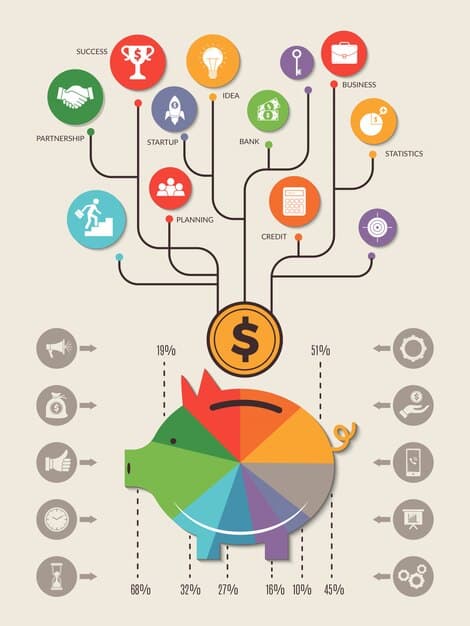Government Spending: Analyzing the Impact of the Latest Budget Proposal on Economic Growth

The latest budget proposal unveils strategic shifts in federal allocations, signaling potential impacts on various sectors and aiming to stimulate economic expansion through targeted investments and fiscal adjustments that merit close scrutiny.
Understanding how government spending influences the economy is paramount, and the latest budget proposal to Congress offers a crucial lens through which to analyze its potential effects on economic growth, impacting households, businesses, and future fiscal trajectories.
The anatomy of a federal budget: understanding its components and objectives
When we delve into a federal budget, we are essentially looking at a nation’s financial blueprint for the upcoming fiscal year. This document outlines how the government plans to collect revenue, primarily through taxes, and how it intends to allocate those funds across a vast array of programs and agencies. It’s not merely an accounting ledger; it’s a statement of priorities, a reflection of policy objectives, and a crucial instrument for economic management. Each line item, from defense to healthcare, education to infrastructure, represents a deliberate choice about where national resources will be directed.
The objectives behind a budget proposal are multifaceted. Beyond simply funding essential services, budgets are often crafted with broader economic goals in mind. These can include fostering economic stability, reducing unemployment, stimulating innovation, or addressing societal challenges like climate change or healthcare access. The specific allocations within a budget are designed to achieve these aims, often through direct investment, transfer payments, or incentives for private sector activity. For instance, increased spending on research and development aims to boost technological advancement, while investments in infrastructure seek to enhance productivity and create jobs.
Key categories of government expenditure
Government spending can be broadly categorized, each type serving distinct purposes and having differing economic impacts.
- Mandatory spending: This comprises programs like Social Security, Medicare, and certain welfare benefits, where spending levels are determined by existing laws rather than annual appropriations. These entitlement programs represent a significant portion of the federal budget and are often the subject of long-term fiscal debates due to their escalating costs.
- Discretionary spending: This category includes defense, education, transportation, scientific research, and environmental protection. Unlike mandatory spending, these funds are subject to annual appropriations by Congress, allowing for greater flexibility and political influence over their allocation.
- Interest on national debt: A substantial, and often growing, portion of the budget is dedicated to paying interest on the money the government has borrowed over time. This expenditure is non-negotiable and is directly tied to the size of the national debt and prevailing interest rates.
Beyond these core categories, the budget also incorporates revenue forecasts and projections for economic indicators such as GDP growth, inflation, and unemployment. These forecasts underpin the entire budgetary process, as they influence both the projected tax receipts a government expects to collect and the anticipated costs of its various programs. Understanding these foundational elements is the first step in analyzing how a new budget proposal might impact the economic landscape. The interplay between revenue collection and expenditure allocation determines whether a budget will result in a surplus, a deficit, or a balanced fiscal position, each carrying its own set of economic implications.
In essence, a federal budget is a complex document that balances economic realities with political aspirations. It’s a snapshot of a government’s strategic vision, and its careful dissection reveals much about the nation’s economic direction and societal priorities. The proposed changes within the latest budget reflect a calculated move to navigate current economic conditions and lay the groundwork for future growth, or at least, to mitigate potential downturns. This foundational understanding is crucial for any meaningful discussion about its economic effects.
Proposed budget allocations: key shifts and policy priorities
The latest budget proposal from the administration outlines a series of deliberate shifts in spending allocations, reflecting a calculated response to current economic conditions and long-term policy objectives. These changes are not arbitrary; they are the result of intense deliberation, balancing competing interests and aiming to steer the nation’s economy in a particular direction. A close examination reveals a lean towards certain sectors and initiatives, signaling the administration’s immediate and future priorities.
One of the most notable features of this proposal is a significant increase in investment in infrastructure development. This includes substantial allocations for upgrading roads, bridges, public transportation systems, and expanding broadband internet access. The underlying rationale is clear: improved infrastructure can enhance productivity, reduce logistical costs for businesses, and create a multitude of jobs in the construction and related industries. Such investments are often viewed as a direct stimulus to economic activity, with a multiplying effect as wages are spent and supplies are purchased.
Alongside infrastructure, there is a pronounced focus on technological innovation and research. Funding for scientific research agencies, climate change initiatives, and artificial intelligence development has seen a proposed uptick. The goal here is to bolster the nation’s competitive edge in emerging global industries, foster breakthroughs, and transition the economy towards more sustainable and high-tech sectors. This strategic investment is designed to yield long-term returns in the form of new industries, higher-skilled jobs, and enhanced national productivity.
Strategic reallocations and their implications
The budget also proposes strategic reallocations within existing departmental budgets, indicating a deprioritization of some areas to free up funds for others. While complete details are often complex and span thousands of pages, the broad strokes point to a re-evaluation of how federal dollars are currently being utilized. For example, some administrative overheads or less effective programs might see reductions, with the savings redirected towards the aforementioned priority areas.
These shifts are not without potential consequences. Increased spending in one area often means less in another, which can lead to debates about equity, efficiency, and fairness. Understanding these trade-offs is essential for a comprehensive analysis of the budget’s overall impact. For instance, while infrastructure spending might boost construction, a corresponding reduction in social welfare programs could create strains on vulnerable populations or increase local government burdens.
The emphasis on specific sectors also suggests an economic growth model centered on innovation and physical capital. This contrasts with approaches that might prioritize immediate consumer demand or broad-based tax cuts. The administration appears to be betting on supply-side improvements and foundational investments as the primary drivers of future prosperity. This strategy assumes that by enhancing the productive capacity of the economy, long-term growth will naturally follow, leading to higher wages and living standards. The proposed allocations reflect a vision of a more competitive, resilient, and technologically advanced economy.
Economic theory and government spending: a brief overview
The relationship between government spending and economic growth is a fundamental concept in macroeconomics, underpinned by various schools of thought. Understanding these differing perspectives is crucial for appreciating the potential ramifications of the latest budget proposal. While economists largely agree that government spending can influence economic activity, the extent of this influence, and whether it’s always beneficial, remains a subject of ongoing debate.
At the core of much contemporary economic policy is Keynesian economics, which posits that government spending can be a powerful tool for stabilizing the economy, particularly during recessions. In a downturn, when private demand is weak, government spending can fill the gap, boosting aggregate demand, creating jobs, and stimulating further private sector investment. This “multiplier effect” suggests that an initial injection of government funds can lead to a larger overall increase in national income. For example, a government investing in a new highway project not only employs construction workers but also increases demand for materials, transportation, and supporting services, generating a ripple effect throughout the economy.
However, other economic schools offer different perspectives. Classical and neoclassical economists often emphasize the importance of free markets and limited government intervention. They argue that excessive government spending can “crowd out” private investment by increasing competition for capital, driving up interest rates, or diverting resources from more efficient private sector uses. From this viewpoint, government spending, especially if financed by borrowing, could lead to less efficient resource allocation and ultimately hinder long-term economic growth.
The impact of funding mechanisms
The way government spending is financed significantly influences its economic impact. There are primarily three ways governments fund their expenditures:
- Taxation: Funding through taxes involves redistributing existing wealth within the economy. The economic impact depends on the type of tax (e.g., income, consumption, corporate) and who bears the burden. High taxes can disincentivize work and investment, while lower taxes can stimulate them, though they may lead to revenue shortfalls.
- Borrowing (debt financing): When governments spend more than they collect in taxes, they typically borrow money by issuing bonds. This adds to the national debt. While borrowing can provide immediate funds for spending, excessive debt can lead to higher interest rates, deter private investment, and impose a future burden on taxpayers.
- Money creation (printing money): In some cases, governments might finance spending by having the central bank create new money. This is generally disfavored due to its high risk of causing inflation, as more money chasing the same amount of goods and services tends to drive prices up.
Each funding mechanism carries its own set of economic trade-offs and potential consequences. A budget proposal heavily reliant on borrowing, for instance, might raise concerns about fiscal sustainability and future interest burdens. Conversely, one funded by significant tax increases could face criticism for potentially stifling private sector activity. The latest budget proposal implicitly, or explicitly, chooses a path in terms of funding, and evaluating this choice is as important as analyzing the spending allocations themselves. The theoretical underpinnings of these choices shape expectations for economic outcomes.
Potential impacts on various sectors: a detailed analysis
The ripple effects of a federal budget proposal extend far beyond the immediate beneficiaries of government funds, permeating various sectors of the economy. Each allocation, or lack thereof, can stimulate growth in one area while potentially causing contractions or stagnation in another. A detailed analysis of the latest budget reveals a strategic targeting of certain industries, with anticipated knock-on effects across the economic landscape.
The proposed surge in infrastructure spending is poised to be a significant boon for the construction sector. Companies involved in building roads, bridges, and public works projects are likely to experience increased demand, leading to job creation and potential wage growth. This positive impact also extends to industries that supply construction materials, such as steel, cement, and concrete manufacturers, as well as equipment providers. The multiplier effect here is quite direct: more projects mean more jobs, more materials, and heightened economic activity within this cluster of industries.
Furthermore, the emphasis on technological innovation and research and development (R&D) is expected to significantly benefit the tech sector. Increased funding for federal research agencies often translates into grants for universities, private research institutions, and technology companies. This can accelerate innovation in fields like AI, biotechnology, and renewable energy, potentially creating new markets and high-skilled jobs. Startups and established tech giants alike could see opportunities for growth, pushing the boundaries of what is technologically possible and driving future economic value.
Sector-specific consequences and broader implications
While some sectors stand to gain, others might face adjustments. For example, if the budget includes cuts to certain welfare programs or subsidies for specific industries, those sectors and the populations they serve could experience reduced demand or financial strain. Similarly, changes in regulatory frameworks, often accompanying budget proposals, can impose new costs or open up new opportunities for businesses, depending on the nature of the regulations.
The healthcare sector, perennially a major recipient of federal funds, will also likely see significant effects. Any changes to Medicare or Medicaid funding, or new initiatives related to public health, will directly impact hospitals, pharmaceutical companies, and health insurance providers. An increase in funding for preventive care, for instance, could shift demand within the healthcare industry towards primary care services and away from emergency treatments over time.
Government Spending: Analyzing the Impact of the Latest Budget Proposal on Economic Growth also necessitates a look at the fiscal implications for state and local governments. Often, federal budget proposals involve grant programs or matching funds that influence how states and municipalities spend their own revenues. An increase in federal funds for education or public safety, for example, could alleviate financial pressures on local authorities, potentially allowing them to reduce local taxes or invest in other areas. Conversely, cuts in federal aid could force local governments to seek alternative revenue sources or scale back services.
The financial sector will also be watching closely, particularly regarding the budget’s impact on interest rates and the national debt. Heavy government borrowing could lead to higher interest rates, which would affect lending, investment, and consumer behavior. Changes in fiscal policy can influence bond markets, currency values, and investor confidence, all of which have direct consequences for financial institutions and the broader economy. Each sector’s experience will depend on the nuanced details of the budget and the specific policies enacted.
Fiscal responsibility and long-term implications
Discussions surrounding government spending must inevitably address the critical components of fiscal responsibility and the potential long-term implications of budgetary decisions. While short-term economic stimulus is often the immediate concern, the legacy of a budget proposal can extend for decades, shaping the nation’s economic health and intergenerational equity. A fundamental aspect of this is the national debt, which reflects the accumulated deficits of past government spending.
The current budget proposal, in its attempt to balance immediate needs with future aspirations, must contend with the realities of the existing national debt. Any significant increase in spending without a corresponding rise in revenue, or a reduction elsewhere, typically leads to a larger deficit and, consequently, an expansion of the national debt. While borrowing can be a useful tool for financing essential investments or navigating economic crises, unchecked debt accumulation can pose serious risks. High levels of national debt can lead to increased interest payments, which consume a larger portion of the annual budget, leaving less room for other critical programs. It can also put upward pressure on interest rates, making it more expensive for businesses and individuals to borrow, potentially stifling private investment and consumer spending.
Moreover, a burgeoning national debt can raise concerns about fiscal sustainability. If investors perceive that a government’s debt trajectory is unsustainable, they might demand higher returns on government bonds, further increasing borrowing costs. In extreme cases, this could lead to a loss of investor confidence and economic instability. The long-term implications also involve intergenerational equity, as future generations bear the burden of repaying debt incurred today, potentially through higher taxes or reduced public services.
The interplay of deficits, debt, and economic growth
The relationship between deficits, national debt, and economic growth is complex. Some argue that consistent deficits, even if they lead to debt, are necessary for sustained economic growth, especially if the spending is directed towards productive investments like infrastructure or education, which can enhance the economy’s long-term productive capacity. However, others contend that persistent deficits and high debt levels crowd out private sector activity, leading to slower growth in the long run.
- Interest rates: High government borrowing can increase demand for credit, potentially driving up interest rates across the economy. Higher rates can deter businesses from investing and make consumer loans (like mortgages and car loans) more expensive, thereby slowing economic activity.
- Crowding out: When the government borrows heavily, it competes with the private sector for available capital. This can “crowd out” private investment, as financial resources are diverted to fund public spending instead of private enterprises, which are often seen as more efficient allocators of capital.
- Future fiscal flexibility: A large and growing national debt reduces a government’s flexibility to respond to future crises. If a recession hits or a national emergency arises, a government already burdened by high debt may have limited capacity to implement necessary fiscal stimulus measures.
Ultimately, the effectiveness of the latest budget proposal in fostering economic growth hinges not just on the immediate allocation of funds but also on its fiscal prudence and impact on the national debt. A budget that stimulates growth in the short term but undermines long-term fiscal health due to excessive debt could prove problematic. Conversely, a fiscally responsible budget that strategically invests in growth-enhancing areas while managing debt levels can lay a strong foundation for sustained prosperity. The challenge lies in striking the right balance.
Challenges and criticisms: navigating political and economic headwinds
Any significant government budget proposal, particularly one with far-reaching economic implications, is invariably met with a unique convergence of challenges and criticisms. These headwinds stem from diverse sources, ranging from partisan political divides to differing economic philosophies and the inherent complexities of forecasting future economic conditions. Understanding these points of contention is crucial for a complete picture of the budget’s potential reception and effectiveness.
One of the most prominent challenges is navigating the political landscape. A budget proposal is not just an economic document; it’s a political one, reflecting the priorities of the ruling administration. As such, it often faces scrutiny and opposition from political parties with differing ideologies. This can lead to protracted legislative battles, amendments, and even government shutdowns if a consensus cannot be reached. Criticisms often center on the balance between spending and taxation, the allocation of funds to specific programs, and the proposed scope of government intervention in the economy. For instance, an emphasis on social programs might be hailed by one side as compassionate, while lambasted by another as fiscally irresponsible.
Economically, budget proposals are inherently projections, based on current data and future assumptions that may or may not materialize. Forecasts for GDP growth, inflation, and unemployment are subject to numerous unforeseen variables, from global supply chain disruptions to sudden shifts in consumer behavior or international geopolitical events. If the economic reality deviates significantly from the budget’s underlying assumptions, its anticipated impacts on economic growth could be altered, potentially leading to larger deficits or less effective spending than initially planned. This reliance on forecasts makes any budget a calculated risk.
Sources of public and expert criticism
Beyond political sparring, the budget proposal also faces critique from a wide array of public and expert communities.
- Fiscal conservatives: These groups often criticize budgets for excessive spending, particularly if it leads to increased national debt. They advocate for fiscal discipline, reduced government size, and lower taxes, arguing that these measures unlock private sector potential more effectively.
- Social advocacy groups: Conversely, these organizations may criticize the budget for insufficient funding in areas like healthcare, education, or poverty alleviation, arguing that more resources are needed to address societal inequities and ensure a robust social safety net.
- Business associations: While some businesses may benefit from specific budget allocations, others might criticize aspects that increase regulatory burdens, raise corporate taxes, or are perceived as creating an uneven playing field. Their concerns often revolve around competitiveness and profitability.
- Independent economists: Experts often provide nuanced critiques, analyzing the budget’s macroeconomic assumptions, its potential for inflation or deflation, and its long-term effects on productivity and labor markets. They might point out specific areas where the budget’s logic is flawed or where unintended consequences could arise.
The democratic process dictates that a budget proposal is subjected to rigorous public debate, expert analysis, and legislative negotiation. While this process can be lengthy and contentious, it is designed to ensure that diverse perspectives are heard and that the final budget reflects a broad consensus, or at least a workable compromise. The challenge lies in translating these varied criticisms into constructive adjustments that genuinely improve the budget’s ability to foster sustainable economic growth while remaining fiscally responsible. The success of the budget is not just in its passage, but in its ability to withstand, and ideally incorporate lessons from, its most relevant criticisms.
Looking ahead: projections and implications for future policy
As the latest budget proposal moves through the legislative process, attention naturally shifts to its projected influence on the economy and the intricate tapestry of future policy decisions. The immediate impacts on GDP, employment, and inflation are critical, but the budget’s true legacy will be measured by its long-term implications for the nation’s economic structure and the trajectory of fiscal and monetary policy. Analyzing these projections requires a careful consideration of various economic models and a readiness to adapt as real-world data emerges.
The administration’s internal projections typically forecast optimistic outcomes, often predicting sustained economic growth, job creation, and manageable inflation levels as a direct result of their proposed spending and tax policies. These projections serve as a benchmark but are invariably subject to revisions by independent bodies and economic think tanks, which often offer more conservative or alternative outlooks based on different assumptions and models. The median of these forecasts often points towards moderate GDP growth, primarily driven by investments in infrastructure and technology, along with a gradual increase in average wages.
Inflation remains a significant concern, given recent economic trends. While increased government spending can stimulate demand and potentially push prices higher, proponents argue that investments in supply-side capacity (like infrastructure) can ultimately mitigate inflationary pressures by increasing productivity and easing bottlenecks. The budget’s impact on energy prices, for instance, through investments in renewable energy or energy efficiency, could also have long-term implications for overall inflation.
Future policy adjustments and economic resilience
The design of the current budget inherently shapes the options available for future policy. For example, if the budget leads to a larger national debt, future administrations might have less fiscal flexibility to respond to unforeseen economic downturns or national emergencies. This could necessitate more austere fiscal policies or greater reliance on monetary policy tools (like interest rate adjustments) by the central bank. Conversely, if the budget successfully stimulates broad-based economic growth and increases tax revenues, it could create more fiscal space for future investments or tax reductions.
- Monetary policy interplay: The central bank will closely monitor the budget’s impact on inflation and economic activity. Significant fiscal stimulus could prompt the central bank to tighten monetary policy (raise interest rates) to prevent overheating. Conversely, if the budget is perceived as insufficient, the central bank might maintain a more accommodative stance.
- Taxation dialogues: As part of a cyclical process, the budget proposal often reignites debates about the tax system. Depending on the success or perceived shortcomings of the current budget, future policy discussions might focus on reforming tax codes to either generate more revenue, foster specific types of economic activity, or reduce the tax burden on certain groups.
- Sectoral shifts: The long-term effects of targeted spending on specific sectors (e.g., green energy, digital infrastructure) could reshape the economy’s industrial composition. This might lead to new industries emerging, while others face structural decline, necessitating future policies to manage workforce transitions and regional economic development.

Ultimately, the latest budget proposal is not an endpoint but a significant step in an ongoing economic journey. Its short-term impacts will pave the way for longer-term trends, and its success will be measured by its ability to foster sustainable, inclusive economic growth while ensuring fiscal resilience. The implications for future policy are profound, requiring adaptability, continuous evaluation, and a willingness to course-correct as new economic data and societal needs come into focus. The ongoing dialogue around this budget is a crucial part of shaping the nation’s economic destiny.
| Key Point | Brief Description |
|---|---|
| 📊 Economic Growth | Targets increased GDP and job creation through strategic investments in key sectors. |
| 🏗️ Infrastructure & Tech | Significant proposed spending in infrastructure upgrades and technological innovation to boost productivity. |
| 💰 Fiscal Challenges | Navigating national debt, potential interest rate hikes, and balancing short-term gains with long-term fiscal health. |
| ⚖️ Sectoral Impacts | Varying effects on industries—construction and tech likely to benefit, while others may face adjustments. |
Frequently Asked Questions About Government Spending
The primary goals of government spending in a budget proposal typically include stimulating economic growth, creating jobs, fostering technological innovation, maintaining essential public services, and addressing societal challenges like poverty or climate change. It also aims for fiscal stability and prudent management of national finances while aligning resource allocation with policy objectives.
Increased government spending can contribute to inflation by boosting aggregate demand, potentially causing prices to rise if supply cannot keep pace. However, if spending is directed towards productive investments like infrastructure, it can enhance long-term supply capacity, ultimately mitigating inflationary pressures over time by improving efficiency and reducing bottlenecks.
“Crowding out” occurs when increased government borrowing drives up interest rates and reduces the availability of capital for private sector investment. As the government competes for funds, it can make it more expensive for businesses to borrow and invest, potentially stifling private economic activity and long-term growth by redirecting resources from more efficient uses.
The latest budget’s spending priorities are expected to significantly affect the construction sector due to infrastructure investments, and the technology and research sectors through increased R&D funding. Other areas like healthcare, education, and some social welfare programs will also experience direct impacts, depending on specific allocations and reallocations.
A budget proposal contributes to long-term fiscal health by balancing immediate spending needs with sustainable revenue collection and debt management. Prudent investments can foster future growth and higher tax revenues, while excessive borrowing without a clear repayment plan can burden future generations and limit a government’s ability to respond to future crises.

Conclusion
The latest budget proposal represents a critical strategic blueprint for guiding the nation’s economic trajectory. Its intricate design, with targeted investments in infrastructure and technology, aims to stimulate growth, create jobs, and enhance long-term productivity. While facing inherent challenges from economic complexities and political debates, the proposal underscores a deliberate effort to navigate current fiscal realities and lay foundations for future prosperity. The ongoing evaluation of its short-term impacts and long-term implications will be crucial in fine-tuning future fiscal policies and ensuring a resilient economic future.





